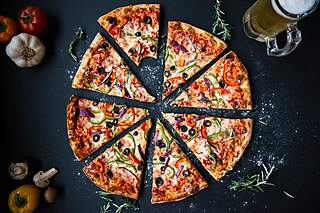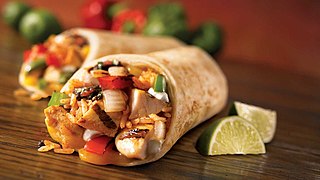 |
| Part of a series on |
| Argentine cuisine |
|---|
| Regional cuisines |
| Ingredients and types of food |
| See also |
This is a list of dishes found in Argentine Cuisine.
 |
| Part of a series on |
| Argentine cuisine |
|---|
| Regional cuisines |
| Ingredients and types of food |
| See also |
This is a list of dishes found in Argentine Cuisine.
| Name | Image | Region | Type | Description |
|---|---|---|---|---|
| Chipá |  | Northeast | snack | small, baked, cheese-flavored rolls made with yucca. The use of yucca to make bread and cakes is traditional to the Guaraní people. [1] |
| Empanadas |  | bread or pastry | a stuffed bread or pastry baked or fried with fillings differing from province to province; in some, it is mainly chicken; in others, beef (cubed or ground depending on the region) is used, perhaps spiced with cumin and paprika; others include onion, boiled egg, olives, or raisins. | |
| Deviled eggs Huevos rellenos |  | appetizer | hard-boiled eggs, shelled, cut in half and filled with the hard-boiled egg's yolk mixed with other ingredients such as mayonnaise and mustard | |
| Picada |  | appetizer | an ensemble of several appetizers (although sometimes it is eaten as a main meal), including various cheeses, cured meats and sausages (such as ham, salame and leberwurst), olives in brine, pickled vegetables, nuts, potato chips, etc. | |
| Choripán |  | sandwich | a sandwich made with chorizo or sausage between two halves of a small French loaf. It is sometimes topped with chimichurri sauce. [2] |
| Name | Image | Region | Type | Description |
|---|---|---|---|---|
| Asado |  | Pampas | meat dish | a range of barbecue techniques usually consisting of beef alongside various other meats, which are cooked on a grill, or open fire. It is considered a national dish. [3] |
| Churrasco |  | Pampas | meat dish | any cut of beef that is sliced slightly thin as a steak and grilled over hot coals or on a very hot skillet. |
| Humita |  | Northwest | main or side vegetable dish | prepared with fresh corn, sautéed onions and some spices, depending on the region or taste. The dough is wrapped in corn husks and boiled. |
| Locro |  | Northwest | stew | a stew of squash, meat, and hominy |
| Matambre |  | Pampas | roulade | a roulade of flank steak and vegetables usually cut in thick slices and served cold. [4] |
| Milanesas |  | meat dish | a thin, breaded and deep fried or baked slice of beef, chicken, or sometimes pork, and even eggplants or soy. | |
| Pascualina |  | savoury pie | a spinach and/or chard pie originally from Italy, very similar to the Greek spanakopita | |
| Polenta |  | Pampas | porridge | cornmeal boiled into a porridge, usually served with cheese and sometimes tomato sauce |
| Pollo al disco | Northwest | stew | a stew of chicken and vegetables cooked in a deep round dish over an open fire | |
| Revuelto Gramajo |  | hash | A common Argentine breakfast dish consisting of fried julienne potatoes, eggs, cheese and vegetables. [5] | |
| Sorrentinos |  | pasta | A type of ravioli created by immigrants from Sorrento, Italy | |
| Vitel toné |  | meat dish | cold, sliced veal covered with a creamy, mayonnaise-like sauce that has been flavored with tuna. It is considered a traditional Christmas dish. [6] [7] |
| Name | Image | Region | Type | Description |
|---|---|---|---|---|
| Chimichurri |  | Cold sauce | sauce used for grilled meat, and marinate fish, and other white meats. It contains: parsley, garlic, salt, peppercorn, chili pepper flakes, oregano, green onion, olive oil, vinegar, lemon juice (fresh) and water. [8] |

Pizza is a traditional Italian dish typically consisting of a flat base of leavened wheat-based dough topped with tomato, cheese, and other ingredients, baked at a high temperature, traditionally in a wood-fired oven.

The region known as Hispanic America and historically as Spanish America is all the Spanish-speaking countries of the Americas. In all of these countries, Spanish is the main language - sometimes sharing official status with one or more indigenous languages or English, and Roman Catholicism is the predominant religion.

Filipino Americans are Americans of Filipino ancestry. Filipinos in North America were first documented in the 16th century and other small settlements beginning in the 18th century. Mass migration did not begin until after the end of the Spanish–American War at the end of the 19th century, when the Philippines was ceded from Spain to the United States in the Treaty of Paris.

A sopaipilla, sopapilla, sopaipa, or cachanga is a kind of fried pastry and a type of quick bread served in several regions with Spanish heritage in the Americas. The word sopaipilla is the diminutive of sopaipa, a word that entered Spanish from the Mozarabic language of Al-Andalus. The original Mozarabic word Xopaipa was used to mean bread soaked in oil. The word is derived in turn from the Germanic word suppa, which meant bread soaked in liquid.
A national dish is a culinary dish that is strongly associated with a particular country. A dish can be considered a national dish for a variety of reasons:

Lionel Andrés "Leo" Messi is an Argentine professional footballer who plays as a forward for and captains both Major League Soccer club Inter Miami and the Argentina national team. Widely regarded as one of the greatest players of all time, Messi has won a record eight Ballon d'Or awards, a record six European Golden Shoes, and was named the world's best player for a record eight times by FIFA. Until 2021, he had spent his entire professional career with Barcelona, where he won a club-record 34 trophies, including ten La Liga titles, seven Copa del Rey titles, and the UEFA Champions League four times. With his country, he won the 2021 Copa América and the 2022 FIFA World Cup. A prolific goalscorer and creative playmaker, Messi holds the records for most goals (474), hat-tricks (36), and assists in La Liga (192). He has the most international goals by a South American male (108). Messi has scored over 800 senior career goals for club and country, and the most goals for a single club (672).

Parmigiana, also called parmigiana di melanzane, melanzane alla parmigiana or, in the United States, eggplant parmesan, is an Italian dish made with fried, sliced eggplant layered with cheese and tomato sauce, then baked. The origin of the dish is claimed by the Southern regions of Calabria, Campania, Apulia and Sicily. Other variations found outside Italy may include chicken, veal, or another type of meat cutlet or vegetable filling.

Chivito is the national dish of Uruguay. It is a sandwich of sliced beefsteak (churrasco), mozzarella, ham, tomatoes, mayonnaise and black or green olives. A chivito commonly also includes bacon and fried or hard-boiled eggs. It is served in a bun, often accompanied by French-fried potatoes. Other ingredients, such as red beets, peas, grilled or pan-fried red peppers, and slices of cucumber, may be added.

Italian cuisine is a Mediterranean cuisine consisting of the ingredients, recipes, and cooking techniques developed in Italy since Roman times and later spread around the world together with waves of Italian diaspora. Significant changes occurred with the colonization of the Americas and the introduction of potatoes, tomatoes, capsicums, maize, and sugar beet—the latter introduced in quantity in the 18th century. It is one of the best-known and most appreciated gastronomies worldwide.

Noma is a three-Michelin-star restaurant run by chef René Redzepi, and co-founded by Claus Meyer, in Copenhagen, Denmark. The name is a syllabic abbreviation of the two Danish words "nordisk" (Nordic) and "mad" (food). Opened in 2003, the restaurant is known for its focus on foraging, invention and interpretation of New Nordic Cuisine. In 2010, 2011, 2012, and 2014, it was ranked as the Best Restaurant in the World by Restaurant magazine. In 2021, it won the first spot in the World's 50 Best Restaurants Awards.

Goat meat is the meat of the domestic goat. The common name for goat meat is simply "goat meat", while meat from young goats can be called "kid meat", capretto (Italian), and cabrito. In South Asian cuisine, mutton refers to goat meat.

A burrito in Mexico is, historically, a regional name, among others, for what is known as a taco, a tortilla filled with food, in other parts of the country. The term burrito was regional, specifically from Guanajuato, Guerrero, Michoacán, San Luis Potosí and Sinaloa, for what is known as a taco in Mexico City and surrounding areas, and codzito in Yucatán and Quintana Roo. Due to the cultural influence of Mexico City, the term taco became the default, and the meaning of terms like burrito and codzito were forgotten, leading many people to create new meanings and folk histories.

Vitello tonnato is a Piedmontese dish of cold, sliced veal covered with a creamy, mayonnaise-like sauce that has been flavored with tuna. It is served chilled or at room temperature, generally in the summertime, as the main course of an Italian meal or as "an exceedingly elegant antipasto for an elaborate dinner". It is also very popular, by inheritance, in Argentina, Uruguay and Paraguay, where it is known by its original name in Piedmontese vitel tonnè and considered a traditional Christmas dish.